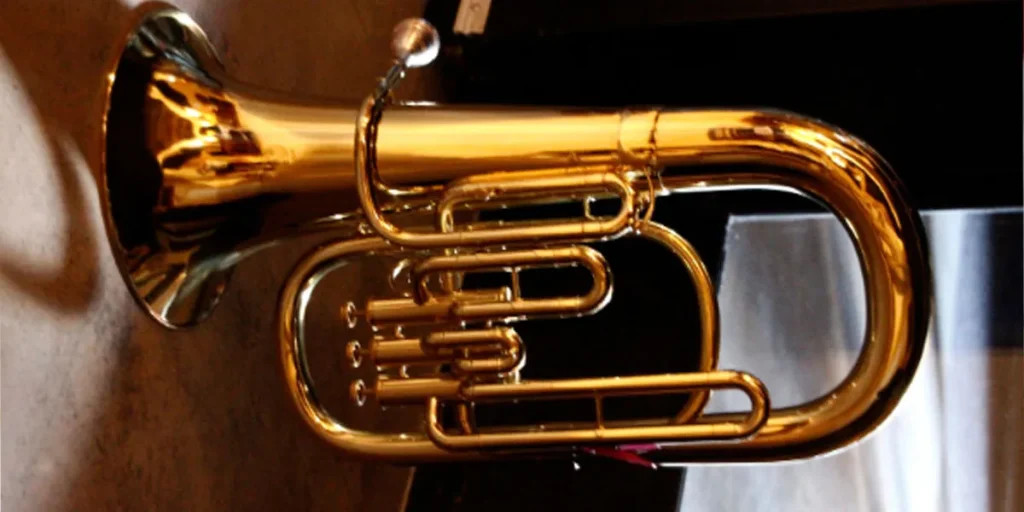A tuba typically weighs between 25 and 35 pounds (11 to 16 kilograms). The exact weight can vary based on the type and model.
The tuba, known for its deep and mellow sound, is the largest and lowest-pitched brass instrument in the orchestra and bands.
Essential in symphonic environments and brass ensembles, the weight of this instrument is a consideration for musicians due to its impact on handling and playability.
Professional models tend to be on the heavier side, reflecting the use of more metal in their construction for enhanced sound quality.
Despite its heft, the tuba’s design features ergonomic considerations to balance weight distribution, ensuring that tubists can perform without undue strain over extended periods.
Understanding the tuba’s weight is crucial for players when selecting the right instrument to suit their physical capabilities and performance needs.

Tuba’s Stature In The Brass Family
The tuba holds a unique position in the brass family. It is the giant, offering the foundational bass sounds that support the entire group.
Comparative Size With Other Brass Instruments
The tuba easily stands out amongst brass instruments. It is the largest and heaviest, dwarfing trumpets and trombones. To understand just how much bigger, consider the following comparisons:
- Trumpets: A common Bb trumpet measures around 19 inches long, with a bell diameter of about 4.75 inches. A standard tuba can be four times larger.
- Trombones: A tenor trombone reaches about 48 inches in total length. Tubas far exceed this, at nearly twice the length.
- French horns: Smaller than tubas, French horns have a bell width around 12 inches. Tubas typically have bell widths exceeding 18 inches.
Physical Characteristics
When discussing a tuba’s physical characteristics, weight and measurements are key. Most tubas weigh between 25 to 35 pounds.
Their complex structure comprises a large body, coiled tubing, and a wide bell. The body can be up to 42 inches tall, and when played, the tuba’s tubing reaches an extended length of around 16 feet.
| Aspect | Measurement |
|---|---|
| Height | Up to 42 inches |
| Length of Tubing | ~16 feet when unraveled |
| Bell Diameter | 18+ inches |
| Weight | 25-35 pounds |
Playing the tuba requires significant breath support and physical endurance due to its size. It might be a challenge for small musicians due to its weight and dimensions.
Heft Of The Horn: Tuba Weight Basics

Average Weight Range
The tuba, known for its grand size, has a weight that may surprise many. On average, as one might expect from such a substantial instrument, a tuba weighs between 20 to 30 pounds (9 to 14 kg).
This range depends on the tuba’s make and model. Smaller, student models can weigh less, making them more manageable for younger players.
| Type of Tuba | Estimated Weight |
|---|---|
| Student Model | 15 – 20 lbs (6.8 – 9.1 kg) |
| Concert Model | 25 – 30 lbs (11.3 – 13.6 kg) |
| Marching Model | 20 – 25 lbs (9.1 – 11.3 kg) |
Factors Influencing Weight
Several factors make a tuba heavier or lighter. These include:
- Material: Brass or fiberglass influence weight.
- Size: Full-sized tubas weigh more than student models.
- Additional Features: Extra valves or attachments add weight.
Professional tubas usually include more brass, which contributes to a heavier and more resonant instrument, while some marching tubas might use lighter materials.
Moreover, an additional rotor or piston valve can tip the scales, adding several pounds to the instrument’s weight.
Material Matters: Composition And Heaviness

The tuba’s weight can surprise many. This brass behemoth’s heaviness hinges on its composition. Different materials mean different weights.
Musicians know this affects transport and playability. Let’s delve into what tubas are made of and how this translates to their overall weight.
Common Materials Used
Tubas are typically crafted from brass. Brass is an alloy of copper and zinc. Sometimes, makers use other metals for variety and cost. Here are the main materials:
- Yellow Brass: This standard material gives a bright sound and sturdy construction.
- Gold Brass: Richer in copper, it offers a warmer tone and slightly more weight.
- Silver: Often used for plating, it adds a distinct look and subtle weight increase.
- Fiberglass: A lightweight alternative to brass, often used in marching bands for easier carry.
How Materials Affect Weight?
The material composition impacts the tuba’s weight. Here’s a simplified breakdown:
| Material | Weight Influence |
|---|---|
| Yellow Brass | Standard weight, balanced for general use. |
| Gold Brass | Heavier, due to increased copper content. |
| Silver Plating | Adds minimal weight, mostly aesthetic. |
| Fiberglass | Significantly lighter, eases transportation. |
A full-size brass tuba can weigh from 20 to 30 pounds. Gold brass models may tip the scales slightly more.
Fiberglass tubas, contrastingly, can be as light as 10 to 15 pounds. Choice matters, as material directly affects the instrument’s heftiness.
Types And Tunes: Different Tubas, Different Masses
Imagine a band without its deep, resonate bass notes – that’s a band without a tuba. Not all tubas are created equal; they differ in size, shape, and sound.
This translates to a range of weights across different tuba types. From the compact sousaphone to the grandiose contrabass, each tuba brings its unique weight and tune to the musical table.
Variations In Tuba Types
Diverse styles of tubas cater to various musical genres and performances. We see a spectrum from the smaller E-flat tubas to the larger B-flat tubas. Smaller tubas tend to be lighter, while larger ones lean on the heavier side.
- E-flat Tuba: Common in British brass bands, perfect for higher tunes.
- F Tuba: A favorite for soloists, it balances weight and versatility.
- C Tuba: Often the choice of orchestral professionals; a middle-ground in size.
- B-flat Tuba: The standard for students and marching bands, with a hearty, rich tone.
- Contrabass Tuba: The largest, producing deep, powerful sounds for a profound impact.
Weight Differentials Among Models
Each tuba model brings its own weight to bear, impacting portability and playability
| Tuba Type | Average Weight |
|---|---|
| E-flat Tuba | 12-15 lbs |
| F Tuba | 15-25 lbs |
| C Tuba | 20-30 lbs |
| B-flat Tuba | 20-30 lbs |
| Contrabass Tuba | 25-35 lbs |
Smaller tubas may be easier for young students to handle, while the larger contrabasses might be reserved for more experienced players.
Handling The Heavyweight
Do tuba players need muscles like superheroes? Handling a tuba’s weight requires more than just musical skill.
Physical Demands Of Playing
Musicians often compare playing the tuba to a sporting activity because of the physical demands.
With tubas tipping the scales anywhere from 12 to 30 pounds, performers need both strength and stamina. Here’s what playing this powerhouse instrument involves:
- Posture: Holding the tuba correctly is crucial to avoid strain.
- Breathing: Controlled breathing techniques are needed to play and support the instrument’s weight.
- Endurance: Long performances mean muscles must sustain the tuba’s weight for extended periods.
Young musicians start with lighter models to build up their playing endurance.
Ergonomic Design And Support
In response to the weight challenge, tubas now often feature ergonomic designs to ease the load. Let’s look at the ways these instruments come to the rescue:
- Straps and harnesses redistribute weight from the arms to the shoulders.
- Chair mounts take the burden off entirely, securing the tuba in a playing position.
- Custom grips provide a more natural hand position, reducing the potential for strain.
These advancements ensure that players of all sizes can handle the tuba, focusing on their music rather than the muscle it takes to maintain it.
In examining the tuba’s weight against the musician’s experience, it’s clear that the commitment to mastering this instrument goes far beyond the notes on the page.
With the right physical approach and supportive design, tuba players are well-equipped to manage the heavyweight of their chosen craft.
Beyond The Scale: The Tuba In Performance
The tuba’s heft is just the beginning. Exploring its role in performances unveils a myriad of factors that go far beyond the scale.
Musicians and audiences alike marvel at the tuba’s deep resonance and commanding presence.
Yet, managing this instrument requires considerable effort, impacting transportation and performance.
Transportation Challenges
Lugging a tuba becomes a tale of stamina and strategy. This musical giant, weighing between 20 and 30 pounds on average, presents unique challenges for musicians on the move.
- Case Sizes: Bulky cases can be awkward to handle.
- Vehicle Space: A tuba demands considerable car trunk or backseat space.
- Public Transport: Bringing a tuba on buses or trains requires planning.
Purpose-built tuba wheeled frames or straps become essentials to ease these burdens.
On-stage Maneuvering
Once on stage, the tuba’s mass influences positioning and movement.
Staging Considerations:
- Size necessitates careful placement within the ensemble.
- Quick repositions during performances must be effortless.
The role of stands: Musicians often use tuba stands for support, reducing fatigue.
Refer to performance layout for optimal tuba position.In essence, tuba players negotiate significant hurdles, from transit to performance. Their dedication ensures the tuba’s deep tones resonate in every corner of the auditorium.
FAQs About the Weight of a Tuba
What Is The Average Weight Of A Tuba?
The average weight of a tuba ranges from 20 to 30 pounds. Some larger tubas, like the sousaphone, can weigh up to 50 pounds. This can vary based on materials and design.
Are Tubas Considered Heavy Instruments?
Yes, tubas are considered heavy instruments. They are one of the heaviest brass instruments, requiring considerable physical strength and endurance to play, especially when marching.
How Do Tuba Weights Compare To Other Brass Instruments?
Tubas are generally heavier than other brass instruments. For instance, trumpets weigh about 2 pounds, trombones about 7 pounds, while tubas significantly tip the scales at 20 to 30 pounds.
Can Tuba Weight Affect Performance?
Tuba weight can affect performance. Heavier instruments may lead to fatigue during long performances or marches. Players may need additional support, like harnesses, to manage the weight.
Conclusion
Understanding the weight of a tuba is crucial for players of all levels. These brass giants vary from 12 to 30 pounds.
As you pursue tuba mastery, consider your physical comfort alongside musical prowess. Remember, choosing the right tuba can elevate your performance to its peak.
Embrace the heft and make beautiful music!
Resources:
https://www.federalregister.gov/documents/2015/01/05/2014-30836/carriage-of-musical-instruments
https://guides.library.appstate.edu/tuba
